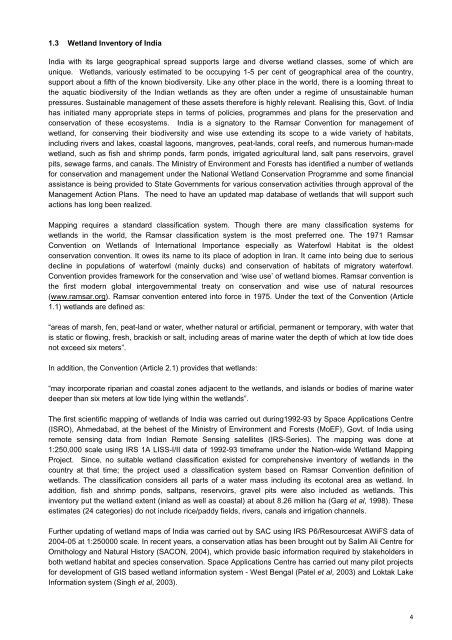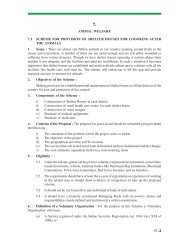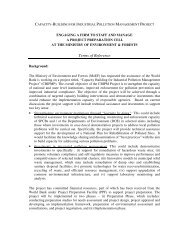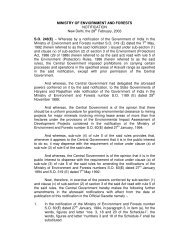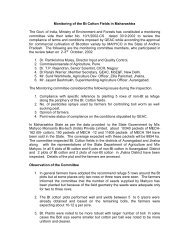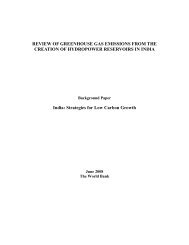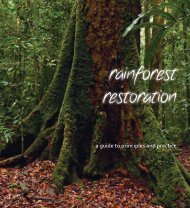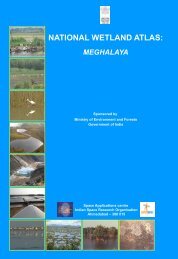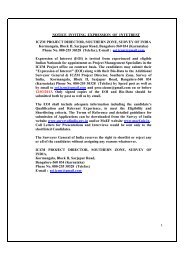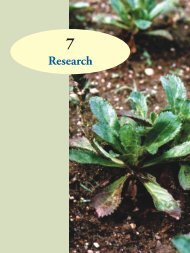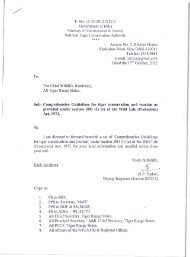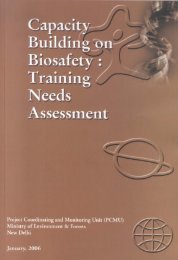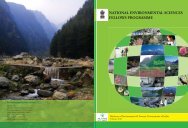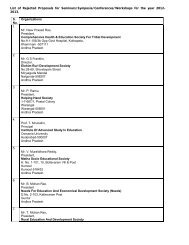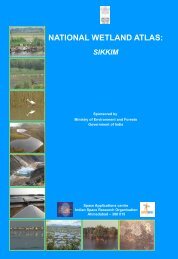Wetlands Atlas - Ministry of Environment and Forests
Wetlands Atlas - Ministry of Environment and Forests
Wetlands Atlas - Ministry of Environment and Forests
You also want an ePaper? Increase the reach of your titles
YUMPU automatically turns print PDFs into web optimized ePapers that Google loves.
1.3 Wetl<strong>and</strong> Inventory <strong>of</strong> India<br />
India with its large geographical spread supports large <strong>and</strong> diverse wetl<strong>and</strong> classes, some <strong>of</strong> which are<br />
unique. <strong>Wetl<strong>and</strong>s</strong>, variously estimated to be occupying 1-5 per cent <strong>of</strong> geographical area <strong>of</strong> the country,<br />
support about a fifth <strong>of</strong> the known biodiversity. Like any other place in the world, there is a looming threat to<br />
the aquatic biodiversity <strong>of</strong> the Indian wetl<strong>and</strong>s as they are <strong>of</strong>ten under a regime <strong>of</strong> unsustainable human<br />
pressures. Sustainable management <strong>of</strong> these assets therefore is highly relevant. Realising this, Govt. <strong>of</strong> India<br />
has initiated many appropriate steps in terms <strong>of</strong> policies, programmes <strong>and</strong> plans for the preservation <strong>and</strong><br />
conservation <strong>of</strong> these ecosystems. India is a signatory to the Ramsar Convention for management <strong>of</strong><br />
wetl<strong>and</strong>, for conserving their biodiversity <strong>and</strong> wise use extending its scope to a wide variety <strong>of</strong> habitats,<br />
including rivers <strong>and</strong> lakes, coastal lagoons, mangroves, peat-l<strong>and</strong>s, coral reefs, <strong>and</strong> numerous human-made<br />
wetl<strong>and</strong>, such as fish <strong>and</strong> shrimp ponds, farm ponds, irrigated agricultural l<strong>and</strong>, salt pans reservoirs, gravel<br />
pits, sewage farms, <strong>and</strong> canals. The <strong>Ministry</strong> <strong>of</strong> <strong>Environment</strong> <strong>and</strong> <strong>Forests</strong> has identified a number <strong>of</strong> wetl<strong>and</strong>s<br />
for conservation <strong>and</strong> management under the National Wetl<strong>and</strong> Conservation Programme <strong>and</strong> some financial<br />
assistance is being provided to State Governments for various conservation activities through approval <strong>of</strong> the<br />
Management Action Plans. The need to have an updated map database <strong>of</strong> wetl<strong>and</strong>s that will support such<br />
actions has long been realized.<br />
Mapping requires a st<strong>and</strong>ard classification system. Though there are many classification systems for<br />
wetl<strong>and</strong>s in the world, the Ramsar classification system is the most preferred one. The 1971 Ramsar<br />
Convention on <strong>Wetl<strong>and</strong>s</strong> <strong>of</strong> International Importance especially as Waterfowl Habitat is the oldest<br />
conservation convention. It owes its name to its place <strong>of</strong> adoption in Iran. It came into being due to serious<br />
decline in populations <strong>of</strong> waterfowl (mainly ducks) <strong>and</strong> conservation <strong>of</strong> habitats <strong>of</strong> migratory waterfowl.<br />
Convention provides framework for the conservation <strong>and</strong> ‘wise use’ <strong>of</strong> wetl<strong>and</strong> biomes. Ramsar convention is<br />
the first modern global intergovernmental treaty on conservation <strong>and</strong> wise use <strong>of</strong> natural resources<br />
(www.ramsar.org). Ramsar convention entered into force in 1975. Under the text <strong>of</strong> the Convention (Article<br />
1.1) wetl<strong>and</strong>s are defined as:<br />
“areas <strong>of</strong> marsh, fen, peat-l<strong>and</strong> or water, whether natural or artificial, permanent or temporary, with water that<br />
is static or flowing, fresh, brackish or salt, including areas <strong>of</strong> marine water the depth <strong>of</strong> which at low tide does<br />
not exceed six meters”.<br />
In addition, the Convention (Article 2.1) provides that wetl<strong>and</strong>s:<br />
“may incorporate riparian <strong>and</strong> coastal zones adjacent to the wetl<strong>and</strong>s, <strong>and</strong> isl<strong>and</strong>s or bodies <strong>of</strong> marine water<br />
deeper than six meters at low tide lying within the wetl<strong>and</strong>s”.<br />
The first scientific mapping <strong>of</strong> wetl<strong>and</strong>s <strong>of</strong> India was carried out during1992-93 by Space Applications Centre<br />
(ISRO), Ahmedabad, at the behest <strong>of</strong> the <strong>Ministry</strong> <strong>of</strong> <strong>Environment</strong> <strong>and</strong> <strong>Forests</strong> (MoEF), Govt. <strong>of</strong> India using<br />
remote sensing data from Indian Remote Sensing satellites (IRS-Series). The mapping was done at<br />
1:250,000 scale using IRS 1A LISS-I/II data <strong>of</strong> 1992-93 timeframe under the Nation-wide Wetl<strong>and</strong> Mapping<br />
Project. Since, no suitable wetl<strong>and</strong> classification existed for comprehensive inventory <strong>of</strong> wetl<strong>and</strong>s in the<br />
country at that time; the project used a classification system based on Ramsar Convention definition <strong>of</strong><br />
wetl<strong>and</strong>s. The classification considers all parts <strong>of</strong> a water mass including its ecotonal area as wetl<strong>and</strong>. In<br />
addition, fish <strong>and</strong> shrimp ponds, saltpans, reservoirs, gravel pits were also included as wetl<strong>and</strong>s. This<br />
inventory put the wetl<strong>and</strong> extent (inl<strong>and</strong> as well as coastal) at about 8.26 million ha (Garg et al, 1998). These<br />
estimates (24 categories) do not include rice/paddy fields, rivers, canals <strong>and</strong> irrigation channels.<br />
Further updating <strong>of</strong> wetl<strong>and</strong> maps <strong>of</strong> India was carried out by SAC using IRS P6/Resourcesat AWiFS data <strong>of</strong><br />
2004-05 at 1:250000 scale. In recent years, a conservation atlas has been brought out by Salim Ali Centre for<br />
Ornithology <strong>and</strong> Natural History (SACON, 2004), which provide basic information required by stakeholders in<br />
both wetl<strong>and</strong> habitat <strong>and</strong> species conservation. Space Applications Centre has carried out many pilot projects<br />
for development <strong>of</strong> GIS based wetl<strong>and</strong> information system - West Bengal (Patel et al, 2003) <strong>and</strong> Loktak Lake<br />
Information system (Singh et al, 2003).<br />
4


